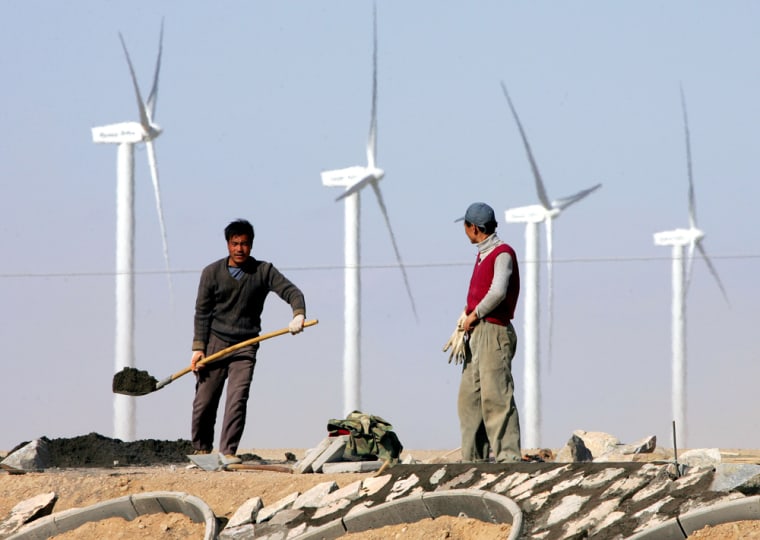Producers of half the world’s “greenhouse” gases are angling for more private investment to create cleaner energy technologies and help slow global warming.
Secretary of State Condoleezza Rice, Energy Secretary Samuel Bodman and presidential adviser James Connaughton will meet next week in Sydney, Australia, with representatives from five Asian and Pacific nations. Along with the U.S., these countries account for nearly half the world’s population, energy use and economic output.
The White House said its talks with Australia, China, India, Japan and South Korea will enhance rather than replace the Kyoto climate treaty that President Bush rejected because of its mandatory cuts in carbon dioxide, methane and other gases.
“It’s a complement to it,” Connaughton, chairman of the White House Council on Environmental Quality, said Wednesday. “For the countries in Kyoto, it will be a very useful tool for them to meet their obligations.”
Among major developed nations, only the United States and Australia reject the 1997 treaty negotiated in Kyoto, Japan, that mandates specific cutbacks in emissions of carbon dioxide and five other gases by 2012 in 35 industrialized countries.
U.S.: Growth can pay for change
China and India signed the treaty as developing nations, exempting them from the first round of emissions cuts. Japan must cut emissions by 6 percent below 1990 levels, and South Korea by 5 percent.
Fossil fuel-burning in the U.S. produces one-quarter of the world’s gases that many scientists blame for trapping heat in the atmosphere like a greenhouse. The Bush administration advocates slowing the growth rate of those gases, not reversing the trend.
Connaughton said the “Asia-Pacific partnership” announced last July would drum up more private investment for common goals. They include U.S. and Chinese plans to improve energy efficiency in coal-burning power plants and cut acid rain-causing sulfur dioxide emissions.
“This is harder than negotiating a diplomatic document, because this is creating real work plans,” he said. “The only way to reduce the environmental impact of growth in key developing countries like China and India is through growing the economies that will pay for the efficiency and pollution controls that make the cuts possible. We welcome their growth.”
Taming the Chinese dragon
Far more will be required if China’s economy keeps expanding at its current rate, said Lester Brown, president of the Earth Policy Institute, an environmental research group.
He argues in a new book that China could reach current U.S. income and consumption levels by 2031 — and the world lacks the basic resources to sustain that.
“China is demonstrating that the Western economic model, the fossil fuel-based, automobile-centered, throwaway economy is not going to work,” he said Wednesday. “And if it won’t work for China, it won’t work for India. Nor will it work for the other 3 billion people in developing countries also dreaming the American dream.”
European wind farms, Japanese solar rooftops, U.S. hybrid cars, South Korea’s reforested hills and bicycle-laden streets in Amsterdam, the Netherlands, are all examples of the “eco-economy” Brown has in mind.
Building it, he said, would require $161 billion a year in global spending on renewable energy, diversified transportation and far greater reuse and recycling of materials.
China is experimenting with solar and wind power, and has taken steps to reduce vehicle emissions, which are tied to global warming.
Smaller cars encouraged
The country’s top economic planning body said Thursday that China will encourage the manufacture and use of small, low-emission cars, overturning current restrictions on them.
Parking fees for small cars should be lower, officials should lead the way in using them and limits on their use as taxis should be lifted, the National Development and Reform Commission said in a statement on its Web site.
“The safety, power and appearance of energy saving and environmentally friendly low-emission cars have all improved greatly,” the commission said, adding that all restrictions should be lifted by March 1.
China will also promote the development of cars that use fuels other than gasoline and diesel and draft tax policies to coax customers towards smaller and more efficient vehicles.
At present 84 Chinese cities restricted the purchase and use of small cars, the China Daily said.
The commission said small cars had been discouraged because of “noise and air pollution, poor safety and unattractive appearance.”
But as oil prices rise, the appetite for smaller cars had been growing -- those with under 1.6 liter capacity had accounted for 66 percent of sales of domestic vehicles in the first 11 months of last year -- and car makers were keen to capitalize on the opportunities the new policy offers, the China Daily said.
